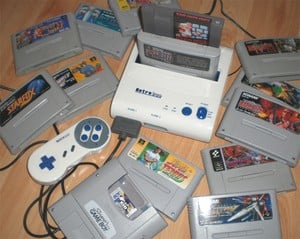
Retro gaming is a hobby that is both rewarding and enlightening; like leafing through an old book or listening to a record from many moons ago, there’s an element of discovery for those who weren’t around to enjoy vintage titles when they were first released. Conversely, those of us old (and wise) enough to remember the classic systems first time around gain a hearty dose of nostalgia from digging out ageing hardware and firing up long-lost favourites.
The trouble is, nothing is ever built to last forever. While gamers tend to believe that their trusty cartridge-based consoles won’t ever fail them, the fact remains that all technology has a finite lifespan. Sooner or later, your beloved NES/SNES/whatever is going to shuffle off its mortal coil and join the great silicon heaven in the sky.
Subscribe to Nintendo Life on YouTube841k
Thankfully, when this event occurs you have several options available – one being the Wii’s handy Virtual Console service, of course. However, for those of you that own games that for whatever reason are not currently available for purchase online (or merely desire something more tangible than digital downloads) there’s always the “FamiClone” route.
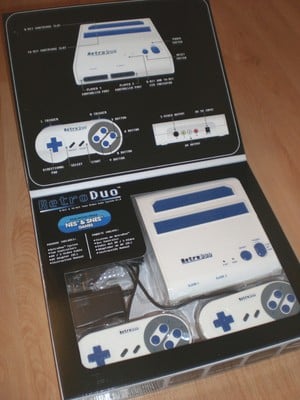
FamiClones – which are basically unofficial systems that will play NES and Famicom titles but are produced without Nintendo’s consent – have been around for years. However, it’s only now that these machines have gained larger acceptance, and this is largely due to the fact that many of Nintendo’s NES and SNES-related patents ran out around 2005. Because of this, it’s no longer illegal to produce consoles that play Nintendo software, and this has led to an increase in “fake” systems hitting store shelves. We’ve already seen the likes of the Neo-Fami and FC Twin grabbing the headlines, but arguably the best machine released so far is Retro Bit's Retro Duo.
As the name suggests, this machine plays both NES and SNES cartridges and promises a surprisingly high compatibility with software. You see, many previous FamiClones have struggled with certain titles, such as Castlevania III: Dracula’s Curse on the NES and Super Mario RPG on the SNES. Super FX-chip titles – like Star Fox and Stunt Race FX – have also been notoriously difficult to get running on these consoles, thanks to the unique graphics-boosting hardware contained within the cart itself.
The Retro Duo isn’t 100% perfect by any means and according to reports there are some games which still stubbornly refuse to run, but for the most part the compatibility is excellent. It even accepts the Super Game Boy device (for playing handheld Game Boy titles) and the Game Genie cheat cartridge – two items which have confounded previous FamiClones.
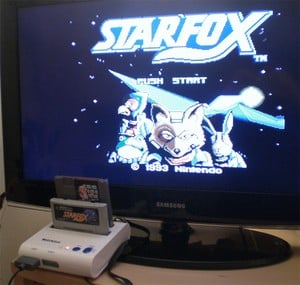
However, here at Nintendo Life we know that our readers are going to want more solid evidence than idle rumour and hearsay; to get the official verdict on this intriguing machine we got hold of a unit (thanks to our friends at Stone Age Gamer) and duly put it through its paces. The results are as follows...
The Hardware
The Retro Duo is surprisingly compact, measuring about 6 inches by 6 inches. The version we were sent is fashioned out of glossy white and blue plastic, but black/red, silver/black and metallic red/gold versions are also available. It’s not the world’s most attractive piece of video game hardware, but you certainly wouldn’t call it ugly. Build-quality is impressive for a machine with such humble origins; while it’s obviously not up to Nintendo’s high standards, it never feels like it’s about to fall apart at any point.
The Interface
Two SNES-like pads are included with the system. When we initially laid eyes on them we expected the worst; they look cheap and nasty, to be perfectly blunt. However, once we hooked them up we were pleased to discover that their performance is pretty decent, offering almost exactly the same degree of control as an official equivalent.
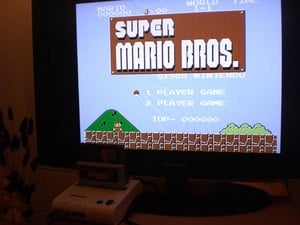
However, if you can’t bear the thought of using these heathen joypads you’ll be reassured to learn that the Retro Duo has two standard SNES controller ports, so you can use your original pads if you so wish.
Picture Output
The machine comes with two AV outputs – Composite and S-Video. The latter offers the best image quality for SNES gaming, but it makes NES titles look washed out and fuzzy (probably due to the fact that S-Video wasn't a common standard at the time the NES hit the shelves), so you're best off using the composite connection to play 8-bit Nintendo games. It’s not a huge problem, though; the included AV cable features both sets of connections so you can just plug everything into your TV and switch between the two settings as you move between NES and SNES titles.
European gamers will be disgruntled to note that the superior RGB SCART option isn’t available here, so there’s a chance that your games will end up looking notably worse on the Retro Duo than they did on your original SNES console. North American gamers will of course be none the wiser thanks to the fact that SCART never really caught on in that part of the world.

Getting Your Game On
From what we've read about the Retro Duo online, there seems to be some confusion as to what games it actually accepts, so here’s the low-down: The Retro Duo will play US/European NES titles and US/Japanese/Euro SNES titles straight out of the box. However, for Famicom (the Japanese version of the original NES) titles you’ll need a 60-pin to 72-pin pass-through converter. These can be obtained online but if you’re tech-savvy enough then you can construct your own, so long as you have a spare NES cartridge lying around that you don't mind butchering.
As we’ve already mentioned, compatibility is excellent. The Retro Duo handled every Super Famicom game we threw at it, and while we only had one NES game to test – the evergreen Super Mario Bros. – the news on the net is that 8-bit titles work just as well.
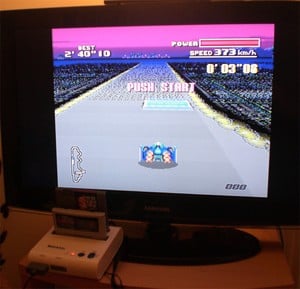
Because FamiClones effectively “emulate” the original hardware rather than replicate it completely, there have been numerous reports of discrepancies between the way a game runs on authentic hardware to how it runs on “clone” hardware. Issues such as speed differences, graphical glitches and out-of-tune sound have been commonplace, but thankfully we can tell you that such problems don’t seem to affect the Retro Duo. Everything we tested ran as it should, and we played a wide range of titles.
Conclusion
While we’ll always be advocates of purchasing original hardware wherever possible, there’s no denying that the Retro Duo is a fantastic little piece of kit. Not only does it offer tremendous convenience – allowing you to play almost any 8-bit or 16-bit Nintendo release – it also saves space under your TV. As vintage machines continue to rise in value this is going to be cheaper than having to shell out for a second-hand SNES and NES, too.
Considering that it costs around the same price as a full-price Wii game, you can't really go wrong with the Retro Duo. If your SNES or NES has recently bit the dust and you have a massive collection of games you want to continue to enjoy, then this is a thoroughly recommended option.
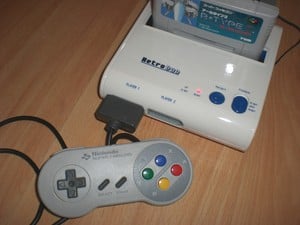
We’d like to thank Stone Age Gamer for providing us with the review unit. The Retro Duo currently retails for an astonishingly reasonable $38.99 (plus shipping) and Stone Age Gamer’s level of service is incredibly professional and quick.
Gamers ordering from outside of North America will need to purchase a step-down voltage converter to use this system.
[source stoneagegamer.com]





Comments 48
Now you guys should review this! http://www.youtube.com/watch?v=wed_bW8iiEw
Great retro Duo review
Holy sh*t, I just bought one of these for my portable SNES!
Can't wait for it to come in the mail...
Interesting. Still have my SNES under my tv, but I never got a chance to play an NES.
what i quinkidink. i was just playing f-zero right now.
anyway, after reading corbies review on his site, i went ahead and bought this instead: http://www.amazon.com/SNES-Video-System-Not-Machine-Specific/dp/B000SC1MUM
so far it works great
@irken004 I saw that same review on the Vii awhile ago. Classic
Oh, and one interesting fact that I liked, they're region free.
@briunj04 - The FC Twin has lower compatibility than the Retro Duo, so I'm told. It won't run Castlevania III or Super Mario RPG - as far as I know, anyway. You may know otherwise!
@DevilHunterDante Yeah, he's a funny reviewer
Thinkgeek has this one available: http://www.thinkgeek.com/electronics/retro-gaming/b76e/
@irken004 - That's the same system as the one in the review - it's just showing the other colour scheme.
I can't speak for Thinkgeek but what I will say is that Stone Age Gamer's service was faultless. So much so that I've ordered more retro-related stuff from them too, including the new GenMobile (portable Genesis).
Thinkgeek has been very reliable for me, they have some other gaming related items as well. I highly suggest people to Thinkgeek all the time
Wow, two updates in just under an hour! Still, cool update. I love the SNES. NES I haven't played in a while.
I didn't even bother to list the RetroDuo I bought on ebay. I unplugged it and took it straight out to the dumpster and tossed it. In fact, I broke it against the dumpster first to ensure some poor unsuspecting soul didn't find it and mistakenly try to use it.
The NES games rock at the slightest touch and the cart slot on the SNES part bent the pins back on my Chrono Trigger cartridge and ruined it. Maybe it's gotten better, but I wouldn't recommend anything but the real deal for those expensive carts in your collection like Chrono Trigger or Earthbound.
There should be a Super DS adapter so you can play ds games on the big screen with your wii
so this is not a pirate console? o_O cool!
I'm amazed that I'm barely ever envious. Must be my unique trait.
if Nintendo doesn't make one of these i guess I'll buy this one
@Corbie - ouch - sounds like you had a rough time. I can only speak for this version (it says V2.0 on the box so they might have made improvements) but it's as solid as a rock. No problems whatsoever here.
I'll have to invest in this in the future. I don't want to download ROMS when my SNES bites the dust. Playing them with a 360 controller is less fun!
It might be a newer version, because I could barely pull the SNES carts out of the slot it was so tight.
I really REALLY need to get my hands on one of these... too bad I have not seen an European version around...
@Shiryu - All you need is a step-down voltage converter and you can play this in Europe. Simple.
@post7, actually thats fine by me because those are 2 of my 5 games on VC
I like the look of this. But I like the look of this more
@Raylax - I've reviewed that here. Quite a neat machine, to be honest.
Do the controllers that come with it work on the original SNES?
This is tempting as I have American, Japanese and European SNES games and it would be nice to have one console that plays them all. The best I've got at the moment is a modified PAL SNES that plays European and Japanese games with a 50/60hz switch on the side.
Interesting Joystiq had a brief review of Firecore Sage Classic console, and it also looked pretty cool, man at this price I might get them just capture my childhood memories even though I did get a few VC games already.
I got one last year it was a great gift, i didn't have to buy all my old games again and yes the original controllers work fine with the Retro Duo
I never had a SNES or a NES, so maybe I should consider getting this...
@g-silent007, If you were answering my question, I actually wanted to know the reverse. Can the Retro Duo controllers be used on the SNES? Since I only have one working SNES controller, it might be nice to have an extra controller if I find a game that doesn't work on the Retro Duo.
I would imagine so, but I haven't tested it. If it works one way it should work the other way, too.
I own every single compatibility-issue risk game. Consoles are still working and very carefully put away--here's to hoping they both last (still worked the last time I fired them up)
Still got my NES and SNES wired up, as well as a Mega Drive (with Master System adapter) N64, Dreamcast, PS1, XBOX1, and Wii, all sharing the same space.
No game is too old to enjoy, that is my motto.
This is one of the best pieces so far on this site. I really really enjoyed it. Thanks.
The silver/black version looks good. But I think with the added postage to here makes it more expensive than if i got both used systems here.
Does this thing play Kirby Super Star, I ask foolishly.
Isn't this thing, like, dodgy n' stuff?!
Nevermind.
This is a great set up for US gamers, you can't really argue with NES/ SNES and Japanese Super Famicom compatibility, but I presume that UK importers would have to consider extra shipping and the lack of RGB is a bit of a shame. The actual design of the machine, as it is layed out in the box, looks pretty nifty. I love the name 'Stone Age Gamer', I need to take a club to my Amiga and drag it into my cave to get it to work.
Thanks for your feature @Damo I played a game of 'spot the Super Famicom' cart in the main pic. I have not raced through Seta's Exhaust Heat in ages, Konami's Japanese artwork was particularly ace. I like the Super Game Boy Kid Dracula screen, too.
@Dicesukeinuzuka A DS adapter, TV player thingamajig, would be great, even if the screen was split in two. There is something about playing portable games on a TV screen, it may go against the purpose of a handheld, but I still play PSP and GBA, Game Boy Player (GCN) games on my telly.
I've been delaying buying one of these all year and it seems like its finally time.
Apparently, these things don't run Castlevania III. So however nice they may be for compatability, I'd call that a pretty big gap.
@KingElemento - Did you even read the feature? This runs Castlevania III. It's one of the only FamiClones that does.
Thanks for this review Damo. I've been wanting something like this for a while now but never knew which one to get. I just placed an order!
good my local gamechange has one that also gots a bult in sega genisis and somthing else
I ordered on off eBay it cost £44 with delivery so not too bad as long as i don't get snagged by import tax. (Usually gifts over £40 get taxed).
I was just wondering what step down voltage adapter did you used in the review. Cheers!
@swerd_murd and others: The youtube videos and reports of the FCTwin having sound/colour issues are old. The latest FCTwin has flawless NES sound reproduction. And people need to stop calling these clones 'emulators'. These do not run any kind of NES/SNES software emulators. They have aftermarket 3rd party processors/hardware that directly reads the game cartridge information. That is why the FCTwin has TWO seperate motherboard sections for NES/SNES. In fact, I have my own video review of the latest FCTwin here:
http://www.youtube.com/watch?v=3_gULqrrJBU
All footage captured directly from my own FCTwin. Except for the first little part where the early fctwins had inaccurate sound, I snagged that from an older youtube review
This review made a believer out of me, but I think it needs to be said that one problem with the system that is often overlooked is that since it uses SNES gamepad ports, it doesn't support the NES Zapper, so Wild Gunman & DuckHunt automatically become unplayable. Stone Age Gamer had this in its description:
"The Retro Duo console uses Super Nintendo compatible controllers and devices such as the Super Scope, but cannot use Nintendo compatible controllers and devices such as the NES Zapper peripheral for Duck Hunt. The Super Nintendo controller buttons otherwise map to the NES controller inputs."
Does the Super Scope work with these games being played on a Retro Duo? If to play these games, is the original NES still the better option?
It's a brilliant console. All ntsc snes & super famicom games have worked so far. All pal snes games before 1993 work so far. All famicom games with honey bee converter work so far. Super Mario 2 & 3 working, milons secret castle & WWF wrestlemania steel cage nes games work. Digger T Rock (PAL) (Game plays title screen, in game crashes with graphics glitch, it's unplayable).
Will an NES Everdrive work with this system?
Show Comments
Leave A Comment
Hold on there, you need to login to post a comment...